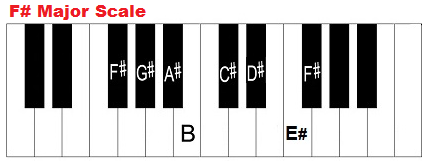In this lesson, we learn how to play the F sharp major scale. This scale consists of the pitches F♯, G♯, A♯, B, C♯, D♯, and E♯. Its key signature has 6 sharps. The relative minor of F sharp major is D sharp minor.
F sharp is the enharmonic equivalent of Gb. The G flat major scale makes use of the same keys on the piano and sounds the same as the F# major scale. The difference is the names of the notes. The notes of the G flat major scale are G♭, A♭, B♭, C♭, D♭, E♭, and F.
To learn more about this scale and others, check out my course, Learn Scales & Music Theory & Give Yourself An Upper Hand.
F sharp Major Scale Intervals
- Tonic – The 1st note of the F-sharp major scale is F#.
- Major 2nd – The 2nd note of the scale is G#.
- Major 3rd – The 3rd note of the scale is A#.
- Perfect 4th – The 4th note of the scale is B.
- Perfect 5th – The 5th note of the scale is C#.
- Major 6th – The 6th note of the scale is D#.
- Major 7th – The 7th note is E#.
- Perfect 8th – The 8th note is F#.
F Sharp Major Scale Diagrams
Here’s a diagram of the F# major scale on the treble clef.
Here’s a diagram of the F# major scale on the bass clef.
Video:
Here’s the F# major scale on piano.
Scale Degrees:
- F# is the tonic of the F-sharp major scale.
- G# is the supertonic of the F-sharp major scale.
- A# is the mediant of the scale.
- B is the subdominant of the scale.
- C# is the dominant of the scale.
- D# is the submediant of the scale.
- E# is the leading tone of the scale.
- F# is the octave of the scale.
Major scales are formed by combining whole step and half step intervals. They are based on the formula W-W-H-W-W-W-H. “W” stands for whole step, and “H” stands for half step. To count up a whole step (whole tone), count up by two physical piano keys, either white or black. To count up a half step (semitone), count up from the last note up by one physical piano key, either white or black.
Using this formula, let’s form an F sharp major scale. Our starting note is F#. From F#, move up a whole step to G#. From G#, go up one whole step to A#. Next, we move up a half step from A# to B. Next, we go up one whole step from B to C#. From C#, we move up a whole step to D#. Next, we move up one whole step from D# to E#. Finally, we move up a half step from E# to F#.
F Sharp/G Flat Major Scale Piano Fingering:
- Notes: G♭, A♭, B♭, C♭, D♭, E♭, F, G♭
- Notes: F♯, G♯, A♯, B, C♯, D♯, E♯, F♯
- Fingerings (Left Hand): 4, 3, 2, 1, 3, 2, 1, 4
- Fingerings (Right Hand): 2, 3, 4, 1, 2, 3, 1, 2
The finger numbers are as follows: Thumb: 1, index finger: 2, middle finger: 3, ring finger: 4, pinky (little) finger: 5.
Triad Chords in the Key of F Sharp Major
Now that we know the notes of the F sharp major scale, let’s learn the triad chords in this scale/key and their notes.
- Chord I – F sharp major (notes: F# – A# – C#)
- Chord ii – G sharp minor (notes: G# – B – D#)
- Chord iii – A sharp minor (notes: A# – C# – E#)
- Chord IV – B major (notes: B – D# – F#)
- Chord V – C sharp major (notes: C# – E# – G#)
- Chord vi – D sharp minor (notes: D# – F# – A#)
- Chord vii – E sharp diminished (notes: E# – G# – B)
Learn more about the chords in the key of F sharp major here.
Modes of the F# major scale:
- Ionian/Major Scale: F♯, G♯, A♯, B, C♯, D♯, E♯, F♯
- Dorian: G♯, A♯, B, C♯, D♯, E♯, F♯, G♯
- Phrygian: A♯, B, C♯, D♯, E♯, F♯, G♯, A♯
- Lydian: B, C♯, D♯, E♯, F♯, G♯, A♯, B
- Mixolydian: C♯, D♯, E♯, F♯, G♯, A♯, B, C♯
- Aeolian/Natural minor scale: D♯, E♯, F♯, G♯, A♯, B, C♯, D♯
- Locrian: E♯, F♯, G♯, A♯, B, C♯, D♯, E♯
Learn how to form major and minor scales in all keys.
Learn how to form all types of scales.
My best recommendation on this site for piano lessons is Piano For All. Check it out. Click here to learn all about Piano For All.
Home Page: How To Play Piano and Keyboard